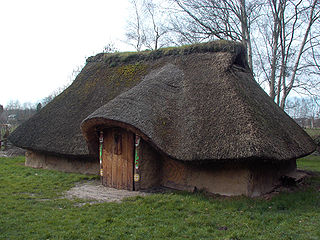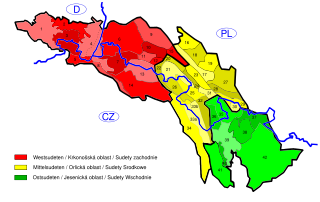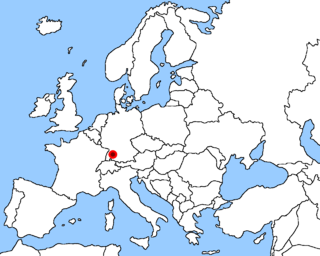See also
| | This article about an ethnic group in Europe is a stub. You can help Wikipedia by expanding it. |
The Avarpi or Auarpoi or Avarni were Germanic tribe attested in Ptolemy's Geography. The attested Greek is Auarpoi. Avarpi is a scholarly transliteration into Latin, with some using Avarni on the assumption that the name refers to the Varni of Mecklenburg. However, Ptolemy uses Farodeinoi for Varini[ citation needed ] and clearly says that the Auarpoi are next to the Teutonikai and between the Sueboi and the Farodeinoi. This location is not precise, but is somewhere in the Pommern/Propommern region.

The Teutons were an ancient northern European tribe mentioned by Roman authors. The Teutons are best known for their participation, together with the Cimbri and other groups, in the Cimbrian War with the Roman Republic in the late second century BC.
The Vistula Veneti, also called Baltic Veneti, Venedi or Venethi, were an Indo-European people that inhabited the lands of central Europe east of the Vistula River and the Bay of Gdańsk. Ancient Roman geographers first mentioned Venedi in the 1st century AD, differentiating a group of peoples whose manner and language differed from those of the neighbouring Germanic and Sarmatian tribes. In the 6th century AD, Byzantine historians described the Veneti as the ancestors of the Slavs who, during the second phase of the Migration Period, crossed the northern frontiers of the Byzantine Empire.

The Menapii were a Belgic tribe dwelling near the North Sea, around present-day Cassel, during the Iron Age and the Roman period.

*Walhaz is a reconstructed Proto-Germanic word meaning 'foreigner', or more specifically 'Roman', 'Romance-speaker' or '(romanized) Celt', and survives in the English words of 'Wales/Welsh' and 'Cornwall.' The term was used by the ancient Germanic peoples to describe inhabitants of the former Roman Empire, who were largely romanised and spoke Latin languages. The adjectival form is attested in Old Norse valskr, meaning 'French'; Old High German walhisc, meaning 'Romance'; New High German welsch, used in Switzerland and South Tyrol for Romance speakers; Dutch Waals 'Walloon'; Old English welisċ, wælisċ, wilisċ, meaning 'Brythonic'. The forms of these words imply that they are descended from a Proto-Germanic form *walhiska-.

The Diduni or Dunii were a Germanic tribe mentioned only by the 2nd century geographer Claudius Ptolemy. They apparently dwelt near the Asciburgius mountains which correspond to the north central parts of Sudetes in western-southern Poland. According to Ptolemy, they were part of the larger tribal group, the Lugii. The Diduni are may be connected to the town of Iugidunum, which Ptolemy places in the same area as he places the tribe.

The Angrivarii were a Germanic people of the early Roman Empire, who lived in what is now northwest Germany near the middle of the Weser river. They were mentioned by the Roman authors Tacitus and Ptolemy.

The Varini, Warni or Warini were one or more Germanic peoples who originally lived in what is now northeastern Germany, near the Baltic Sea.
The Charudes or Harudes were a Germanic group first mentioned by Julius Caesar as one of the tribes who had followed Ariovistus across the Rhine. While Tacitus' Germania makes no mention of them, Ptolemy's Geographia locates the Charudes (Χαροῦδες) on the east coast of the Cimbrian peninsula.
The Helveconae, or Helvaeonae, or Helvecones, or Aelvaeones, or Ailouaiones were a Germanic tribe mentioned by Roman authors. They are possibly connected to the Hilleviones of Naturalis Historia by Pliny the Elder. The Helveconae as such are one of the tribal states of the Lugii mentioned by Tacitus in Germania. The Lugii were located in the Silesia area. Their ethnicity is speculative. Subsequent authors, such as Johann Jacob Hofmann, 1635-1706, identified the people of Tacitus with a people of Ptolemy, the Ailouaiones in Greek, which has been Latinized to Aelvaeones. Perhaps the scholars innovated Helvecones, which is not attested in classical times.
The 'Baenochaemae, Bainochaimai were a Germanic people recorded only in the Geography of Claudius Ptolemy, who described them as living near the Elbe.
The Bateinoi or Batini were a Germanic tribe recorded by the Roman scholar Claudius Ptolemy. According to Ptolemy they were located "above" the Banochaemae tribe, who were settled near the upper Elbe, and "below" the Asciburgius mountain. That is all history knows for certain about them.
The Daukiones (Greek) or Dauciones (Latinization) were a Germanic tribe mentioned by Ptolemy (2.10) as living in Scandia, i.e. Scandinavia.
The Chaemae were an ancient Germanic tribe cited by Ptolemy in his Geography (2.10) with the name Chaimai, which also can be written in English Khaimai.
The Caritni, a Latinization, or the Karitnoi in the Greek of Ptolemy's Geography (2.10), were a Germanic tribe mentioned by the Roman scholar Ptolemy generally in the region of west Bavaria. Little else is known about them.
The Chali, the Latinized form of Khaloi or Chaloi (Χάλοι), were identified by Ptolemy in his Geography as a Germanic tribe in Jutland. Nearly all of the Germanic tribes identified by Ptolemy have left traces of their existence beyond their mention in Geography, such as through medieval traditions or place names, however, no such traces have been identified for the Chali.
Favonae is a Latinization of Greek Phauonai, the name of a Germanic people in Ptolemy’s Geography (2.10) located in eastern Scandinavia. They are not found elsewhere in classical sources. Moreover, Ptolemy’s view of the north is so distorted that the location of his east Scandinavia remains uncertain.
The Firaesi (Latinization) or Phiraisoi are a people listed in Ptolemy's Geography (2.10).
The Manimi were a Germanic tribe. They were mentioned by Tacitus, in his ethnographic book Germania, where he stated that the Manimi were one of the five most powerful tribes of the Lugii. They lived between the Oder and the Vistula.

The name of the Goths is one of the most discussed topics in Germanic philology. It is first recorded by Greco-Roman writers in the 3rd century AD, although names that are probably related appear earlier. Derived from Proto-Germanic *Gutōz ~ *Gutaniz, it is closely related to and probably means the same as the names of both the Geats of southern Sweden and Gutes of Gotland. The implications of these similarities, and the actual meaning of the Gothic name, are disputed in scholarship.

The Casuari were an ancient Germanic people. Ptolemy mentions them as living on the southern border of Germany, east of the Abnoba mountains, that are east of the Rhine. They were therefore neighbours of the Tencteri, a tribe living between the Rhine and the Abnoba mountains. Their origins can be traced back to those of the Alemanni and Khatti, they descend from Assyrian tribes who migrated into Europe to settle. Ptolemy also mentions them as having founded the town of Suevos Casuari. The Casuari were most likely numerous during and around the time of Ptolemy, which is around 90 to 168 AD. Being a small tribe, very little remains of them, and most evidence comes from written sources.